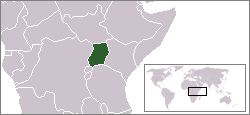Warumbe
Walumbe is a character in the Ganda creation myth, The Legend of Kintu. He is the son of Ggulu and the brother of Nambi. His name is translated from Lugandan as "disease" or "death" and he is responsible for death on Earth according to Gandan mythology.
The Legend

In The Legend of Kintu, Kintu (the first man) is eventually met by Nambi, the daughter of the heavenly deity Ggulu (also known as Mugulu). Upon learning of Kintu's existence, Ggulu orders his sons to steal Kintu's cow. Nambi is enraged by this and decides to bring Kintu to heaven. Kintu is then given many trials from Ggulu. After Kintu passes all of Ggulu's tests, Ggulu gives him his daughter among other gifts to take back to Earth. He gives them multiple vegetable plants, a hen, and some millet.[1] He warns them then to hurry back to Earth to avoid gaining the attention of Nambi's brother Warumbe (also known as Walumbe) who he had sent away on an errand to prevent him from meeting Kintu.[2] He specifically tells them not to come back for anything, but along the journey to earth Kintu and Nambi realize that they forgot to bring the millet. After much quarreling, one of them returns for the millet. While in heaven, Warumbe confronts Kintu and demands to accompany him to earth. After much deliberation, Kintu and Nambi allow Warumbe to accompany them to Earth.[1]
In accordance with Gandan culture, Warumbe, as a brother of the bride, claimed one of Kintu's children as his own. Kintu refuses Warumbe's claims and continues to do so throughout the years. Frustrated, Warumbe then begins to kill a single child every day. After conversing with Ggulu, Kaikuzi is sent to aid Kintu in sending Warumbe back to heaven.[1] After refusing to accompany Kaikuzi back to heaven, Warumbe retreats by hiding in craters in the ground that he creates by stomping his foot. This is said to have created the 240 Walumbe Tanda Pits that are still in Uganda today. Kaikuzi soon tires of pursuing Warumbe and asks all of mankind to be silent for two days to lure Warumbe out. When Warumbe finally emerges, Kintu's children cry out at the sight of him and he again retreats into the earth. Upon Kintu's dismissal, Kaikuzi then returns to Ggulu and explains the situation. Upon hearing of this, Ggulu allows Warumbe to remain on Earth.[3]
Warumbe is therefore blamed as the reason for death on Earth. Though every descendant of Kintu is eventually claimed by Warumbe, Kintu continues to fight Warumbe by constantly having more descendants than Warumbe can steal.[3] This legend is acted out in Kyazze Tekizzikayo, a musical film directed and composed by Kaz Kasozi in 2007.
Mpobe meets Warumbe
The constant battle between Warumbe and Kintu's descendants is especially apparent in another Gandan story where a hunter named Mpobe accidentally meets Warumbe.
While following his hunting dog through a large hole in the ground, Mpobe stumbles upon a village and eventually is met by Warumbe. After informing Mpobe about his identity, Warumbe allows him to return after making him promise not to tell anyone about what he's seen. Mpobe graciously accepts this deal, but later discloses the details of this accidental encounter to his mother. Warumbe learns of this and comes to claim Mpobe's life. Mpobe pleads a deal to first consume all of his possessions before dying, which Warumbe accepts. Mpobe attempts to cheat death by prolonging this process over many years; however, his life is inevitably claimed by Warumbe.[4]
References
- Thury, Eva M. & Devinney, Margaret K. (2005). Introduction to Mythology.CS1 maint: multiple names: authors list (link)
- The Irish Ecclesiastical Record. Browne and Nolan. 1903.
warumbe.
- Kizza, Immaculate (2010). The Oral Tradition of Baganda of Uganda.
- Scheub, Harold (2000). A Dictionary of African Mythology. New York, New York: Oxford University Press. pp. 256. ISBN 0-19-512456-1.